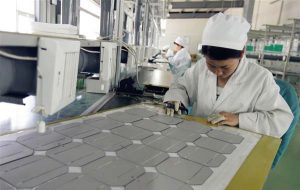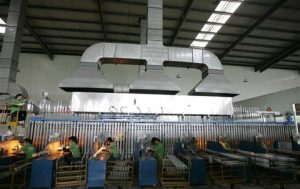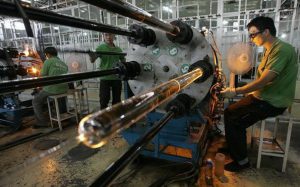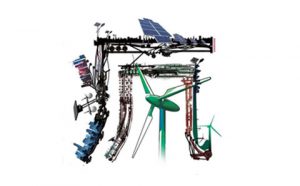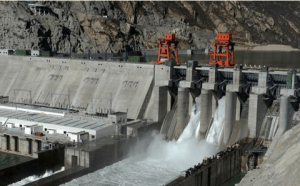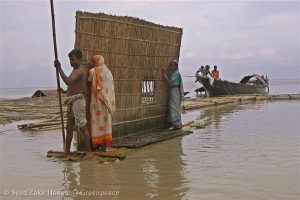Fifty-two solar panels, gleaming in the sunshine, are spread across 70 square metres of a Beijing warehouse rooftop. This relatively small-scale installation cost 60,000 yuan (US$9,700) and began operating in early 2013. It is a demonstration of the type of solar energy the Chinese government would like more of. “Distributed” solar plants, smaller installations close to where the electricity is consumed, are one way to diversify away from smog-producing coal.
In the past five years, China’s government has set ambitious targets for distributed solar, backed by subsidies to encourage people to set up photovoltaic (PV) panel arrays. But so far, growth has been limited.
In January, the National Energy Administration (NEA) set a target of adding 8 gigawatts of distributed solar by the end of 2014. However, by mid-year there was only around 1 gigawatt of new distributed solar in place and there is no sign of a significant uptick in installations. The target is set to be missed.
Compared with wind, solar-energy generation has many things going for it. It uses relatively inexpensive technology, and recent developments have lowered costs. It also produces electricity during daylight, when it is most needed, so is less wasteful than wind.
Of the two types of solar-energy generation, large-scale utility grade and distributed, the latter “has a lot of advantages”, says Yuan Ying, senior climate and energy campaigner at Greenpeace, which owns the Beijing rooftop installation. “It doesn’t need a lot of space to install, and it doesn’t cause transportation problems. China’s electricity consumption is more focused in the east than the west, while the large energy-generation projects are in the west. Why not put the power generation where it is needed? It also offers less monopoly over power generation.”
Not economically viable
The government encourages distributed solar projects by subsidsising installations, and pledging 0.42 yuan (7 cents) for each kilowatt hour sold to the grid. Greenpeace’s rooftop system generates up to 25 kilowatt hours of power a day, covering its own needs and generating a surplus to sell to the grid.
So why are installation targets being missed? Household solar plants are commonplace in rural China; village rooftops glisten with photovoltaic panels for electricity and hot water. But the same is not happening in cities.
That’s because the numbers don’t add up. Installation costs for a distributed solar system are still too high and under the current subsidy system it takes too long to get a return on the initial investment.
The Chinese Renewable Energy Industries Association (CREIA) suggests in a 2014 report that a typical residential building with a rooftop space of 1,000 square metres could set up an 80-kilowatt distributed solar system. Due to the small size of the system, installation costs would remain relatively high, around 720,000 yuan (US$116,000) in total. CREIA calculates that, with China’s current electricity tariffs and subsidies, it would take about 11 years to generate enough power to recoup the initial investment, making the project economically unviable.
“With small scale you don’t have very good economics,” says Peng Peng, CREIA’s director of policy research. “You still need an inverter and other equipment, so your installations costs will be higher, but you get the same subsidy.” Other countries have tackled the problem by tailoring subsidies to support smaller PV plants.
“In Germany, they have different subsidies for small-scale projects than for large-scale projects. In the USA, the residential tariffs are higher than those for industrial customers,” says Peng.
Another reason for the slow uptake may be that China’s residential electricity tariffs are relatively cheap, averaging around 0.4 yuan (6 cents) per kilowatt hour, giving residential consumers little incentive to generate their own electricity. Nor do they make much profit as they can only sell the surplus to the grid at 0.42 yuan.
“In the US, the residential market is a burgeoning one,” says Rosie Pidcock, business development manager for Urban Green Energy, a firm providing green energy solutions. “It’s very profitable and there are a lot of players taking advantage of the opportunity in residential solar.”
China’s pricing structures discourage third-party companies from setting up distributed solar systems for city dwellers, as happens elsewhere. Typically, third-party companies get business by selling electricity to consumers for less than the big generators.
“The residential solar market in China is non-existent, because the electricity for residential users is extremely cheap. The current cost of electricity is one of the strongest drivers of how a project will function economically,” says Pidcock.
Ownership problems
Another problem is ownership of roof space in highrises. In China, most residents and a lot of companies are renters, while buildings may have shared ownership. “A lot of businesses don’t have ownership of the roof,” says Yuan.
Pidcock agrees that ownership structures can act as a barrier to companies installing distributed solar systems, or working with third parties. She cites the example of a company leasing a space in a shopping mall: "They could be the keenest customer in the world, ready to install solar, but it still wouldn’t matter because they don’t have the authority to do that on their property,” she says.
To get started, a company needs to own the space, and be confident they will continue to own it for the operating life of PV plant. Another factor limiting the growth of distributed solar systems is the difficulty of raising finance. Since the government phased out its solar-demonstration projects, anyone setting up a system must find their own funds. This can be difficult to do.
CREIA’s Peng explains that financing is hard to attract “because compared with other industries solar is high risk and low return.” One reason financiers see solar as high risk is because they have no way of assessing the project, she adds. China has no national standards for PV companies, so banks and insurance companies lack frameworks to assess quality, and low-quality projects from the early days have tarnished the industry’s reputation with lenders: “In the Golden Sun [demonstration project] a lot of panels now don’t work at all, so [lenders] don’t have a lot of confidence in the panel quality."
“We need to set up a quality standard system,” she says.
The National Energy Authority has stepped in to try to cushion solar investors against the risk of losing their primary market, issuing a new policy in September. “If the factory’s customers shut off, you can sell off your electricity to the state grid but choose one yuan as the feed-in tariff. Before that, if you sold your electricity to the grid you might only get 0.4 yuan plus the subsidy of 0.42 yuan, but now you can take one yuan. So the lowest return is raised,” says Peng.
If the government can find the right policy formula to overcome the barriers and encourage more people to set up distributed solar systems, Greenpeace’s Yuan believes rapid growth can be achieved. “With wind power, we can see that growth is possible, as long as there are supporting policies in place and the execution of the policies,” she says. “If the government can stimulate distributed solar in the same way, then much higher targets might be possible. “I would not be surprised to see 100 gigawatts.”
